23 Jun Why Do Horses Need Shoes? Understanding the Purpose of Horseshoeing
Well, the staff at Mountain Creek Riding Stable is here to give you some quick answers!
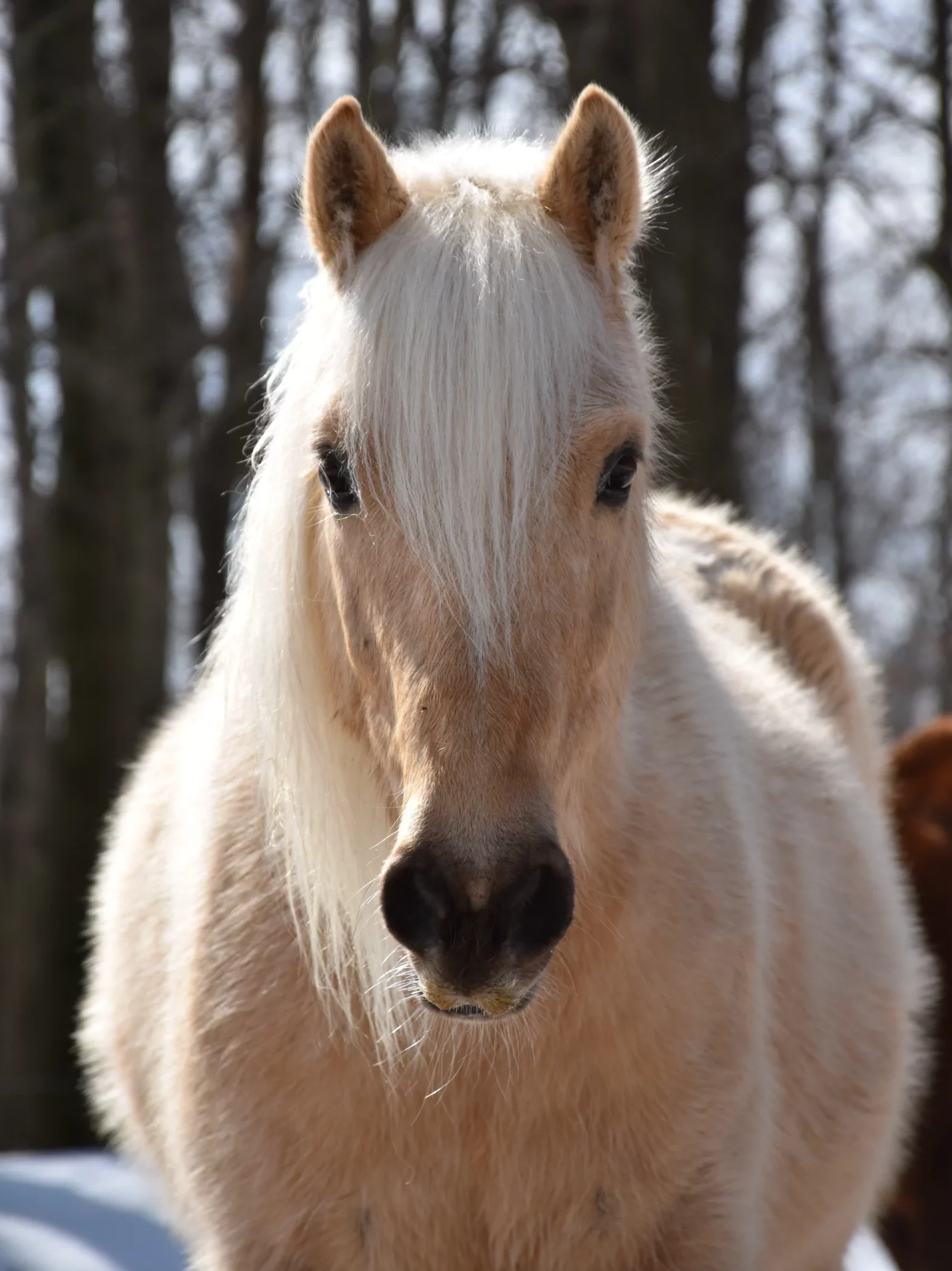
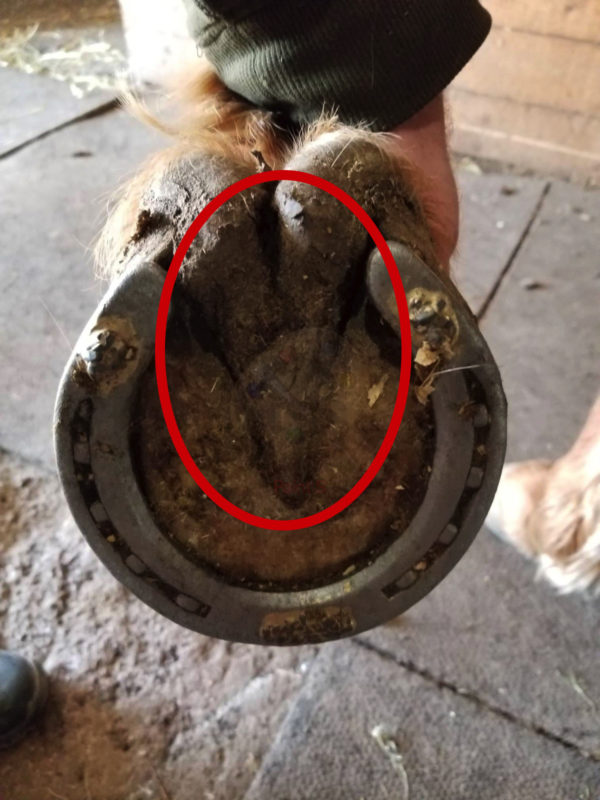
What are horseshoes for?
Horseshoes are designed to protect a horse’s hooves from wear and tear, especially when walking on hard or rocky surfaces. Just like we wear shoes to protect our feet, horses benefit from this extra layer of support. Horseshoes help prevent injury, improve traction, and support the hoof structure, especially for working or trail-riding horses that carry riders or pull loads. They’re an essential part of hoof care for domestic horses who often travel across terrain that would naturally wear down their hooves faster than they can grow.
What is the purpose of horseshoes?
Horseshoes are used to support and protect the hooves of working horses, especially those that walk on hard or abrasive surfaces. The hoof itself is made of keratin—the same protein found in human fingernails and hair—which provides natural durability but still requires protection. Inside the hoof is a soft, sensitive area known as the frog (circled in the image above), which plays an important role in shock absorption and circulation. Without protection, both the hoof wall and the frog can become damaged from repeated impact or rough terrain.
Adding horseshoes helps:
- Prevent excessive wear to the hoof from walking or working on hard surfaces
- Protect the frog from bruising or injury
- Provide traction on slippery or uneven terrain
- Support the hoof structure, especially for horses with health issues or weak hoof walls
- Extend working lifespan by reducing the risk of lameness or injury
In essence, a properly fitted horseshoe helps maintain hoof health, keeps horses comfortable, and ensures they can continue working or riding safely.
What are horseshoes made out of?
Horseshoes are made out of steel in most cases, though there are some exceptions to this. Racehorses usually wear aluminum horseshoes because they are lighter and thus perform better when speed is the top priority.
There are also “boots” that horses can wear in the case of a hoof or foot injury. These “boots” are made of rubber and have a rubber horseshoe built into it that provides a much softer walking surface and more significant support.
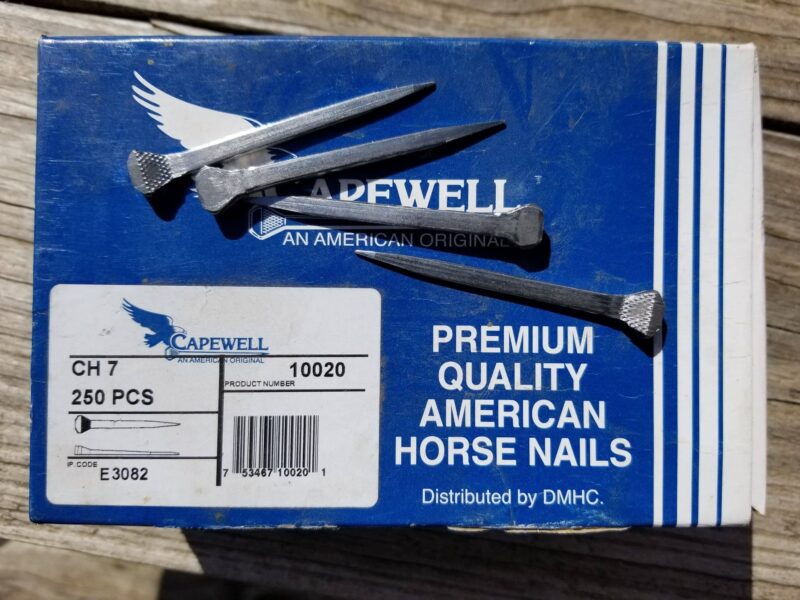
How are horseshoes attached?
People who put horseshoes onto horses are called farriers (also spelled ferrier). Farriers use special nails (like the ones pictured above) to attach the horseshoe to the hoof. As mentioned earlier, a horse’s hoof is made of the same material as your fingernail—keratin—so, just like when you cut your nails, the horse doesn’t feel pain during the process when it’s done correctly.
Here’s a simple breakdown of how a horseshoe is attached:
- Nails are driven through the outer edge of the hoof wall, which has no nerve endings.
- The farrier then bends the nails over to form a secure hook.
- Any sharp nail tips and part of the hoof wall are filed down to ensure a smooth, snug fit.
As the hoof naturally grows out over time, it will begin to overlap the horseshoe. That’s how you know it’s time for the horse to be reshoed.
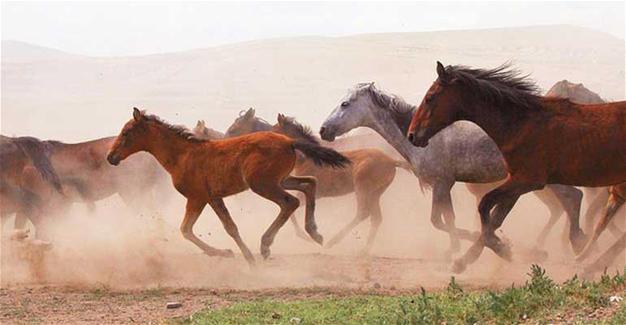
Why don’t wild horses need shoes?
The reason wild horses can exist without shoes is twofold: firstly they do not “work” as hard or as often as a horse with an owner. Therefore, they wear away their hooves slower than the hooves grow. Secondly, they do not have anyone to look after their well-being, so if they have an injured frog or another situation where a shoe would be put on an owned horse – they have to deal with it.
Now and then you may come across an owned horse that doesn’t have any horseshoes. In the working world, horses who don’t wear shoes are usually “barefoot” as a result of having a problem with their feet. Sometimes their hooves are too brittle or they may have broken off a piece of their hoof, so the horseshoe may not be able to be adequately attached. These horses can still do trail rides or work the farm, but they will have greater limitations on how much they work.
Do all Horses need shoes?
Not all horses need to wear shoes. Whether a horse goes barefoot or wears shoes depends on several factors, including their workload, hoof health, and the type of terrain they regularly walk on.
Some horses do just fine without shoes, especially if:
- They primarily walk on soft ground, like pasture or sand
- They have naturally strong, healthy hooves
- They aren’t working regularly or carrying heavy loads
These horses are often referred to as “barefoot horses.” Barefoot horses still require regular hoof trims from a farrier to maintain proper shape and balance, but without the need for shoes.
However, horses that are used for trail rides, farm work, or performance activities usually benefit from the protection and support shoes provide. Rocky or hard surfaces can quickly wear down a hoof, and in some cases, lead to soreness or injury. Shoes help prevent these issues.
In short, not all horses need shoes, but for those that do, proper hoof care and regular shoeing are essential to keeping them comfortable, safe, and sound.
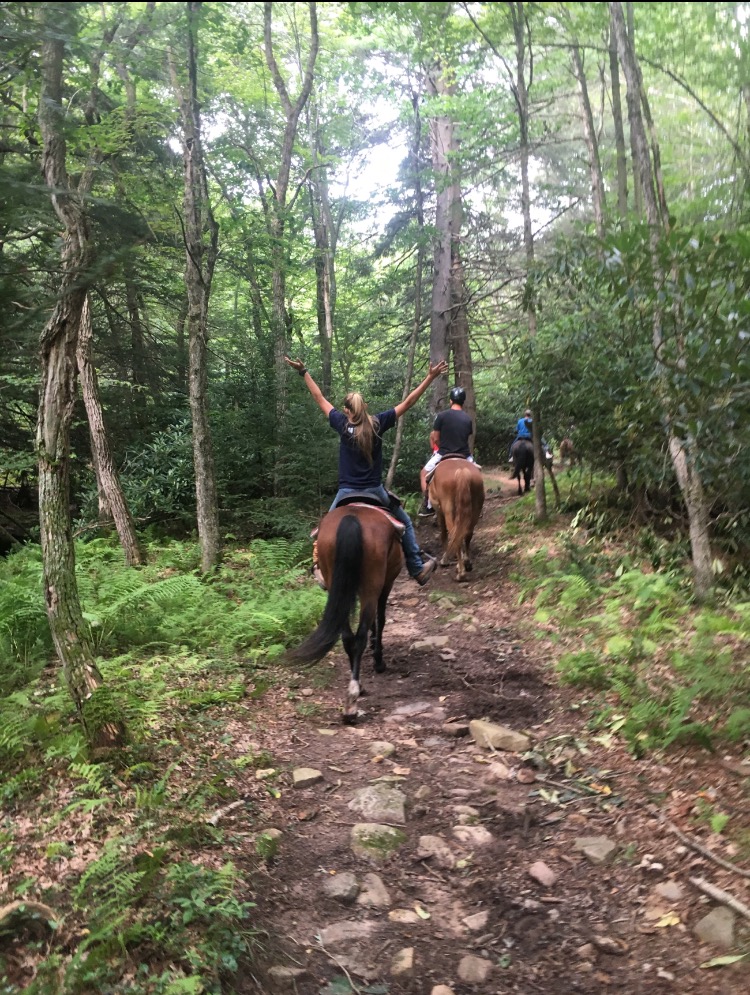
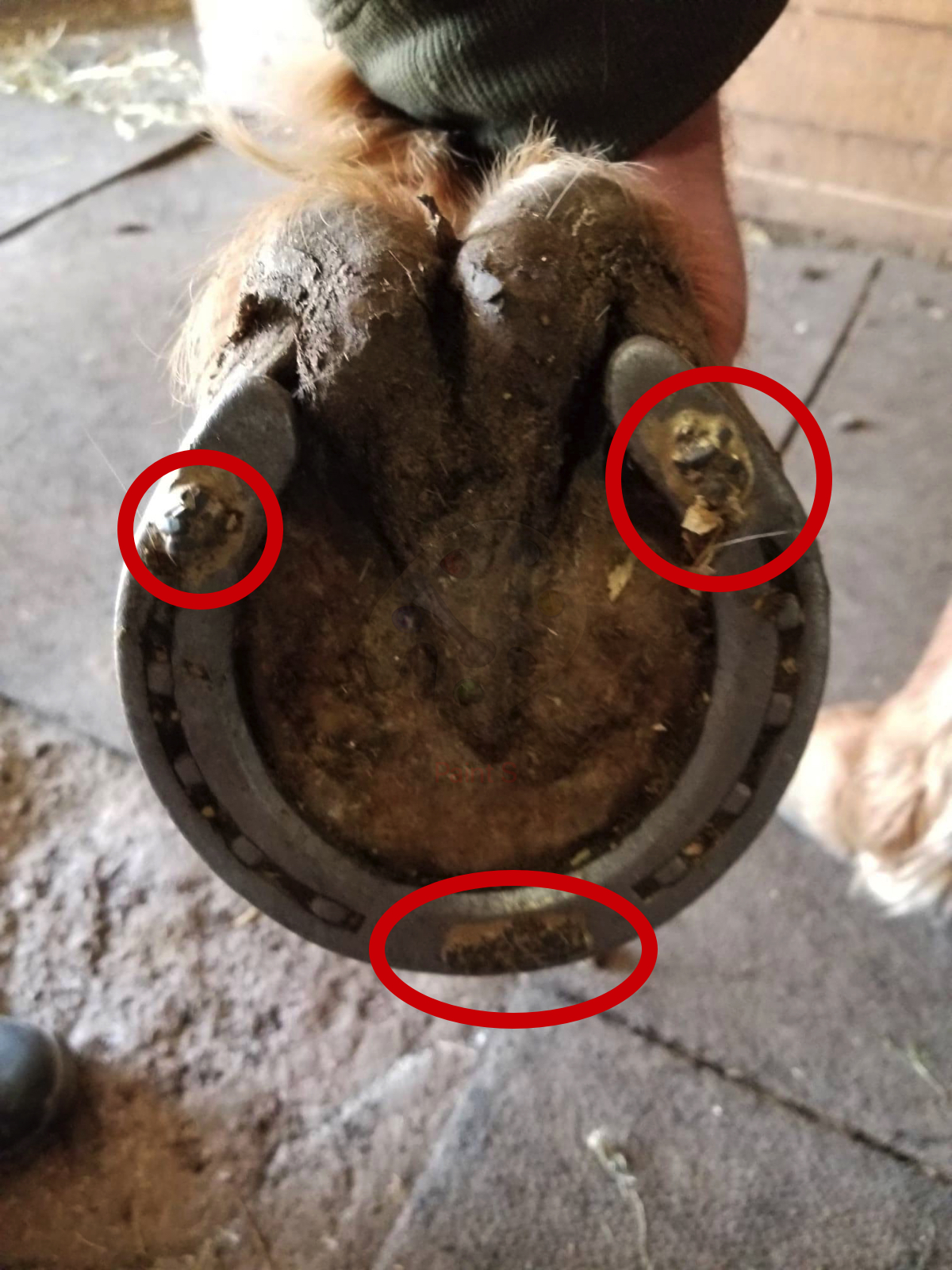
Are horseshoes necessary for trail riding?
Horses that do trail rides are called “hack horses” and for them, shoes are of utmost importance. When the trail ride routes include paved surfaces or hard-packed ground (like that of the Grand Canyon), the hooves can wear away faster than they grow. This can lead to the horses being unable to work. Well-maintained horses will always have shoes to protect their feet and allow them to do the 9-5 grind.
Additionally, at Mountain Creek Riding Stable, we put horseshoes on our horses for their anti-skid properties. Each of our horses gets what is called “Drill Tech” added to their shoes, which is made of a substance called carbraze. Carbraze is a mixture of tungsten carbide particles in a brass/nickel matrix. As the matrix melts, it adheres to both the tungsten pieces and the steel of the shoe. Once it cools, the tungsten pieces stick out and provide extra traction on slippery surfaces, kind of like ice cleats for humans. Safety is the most important part of our business, and this traction makes all the difference during the winter months.
Book a Trail Ride with Confidence
When you’re ready to go for a ride, join us in Pennsylvania for beautiful horseback trail riding in the Pocono Mountains.



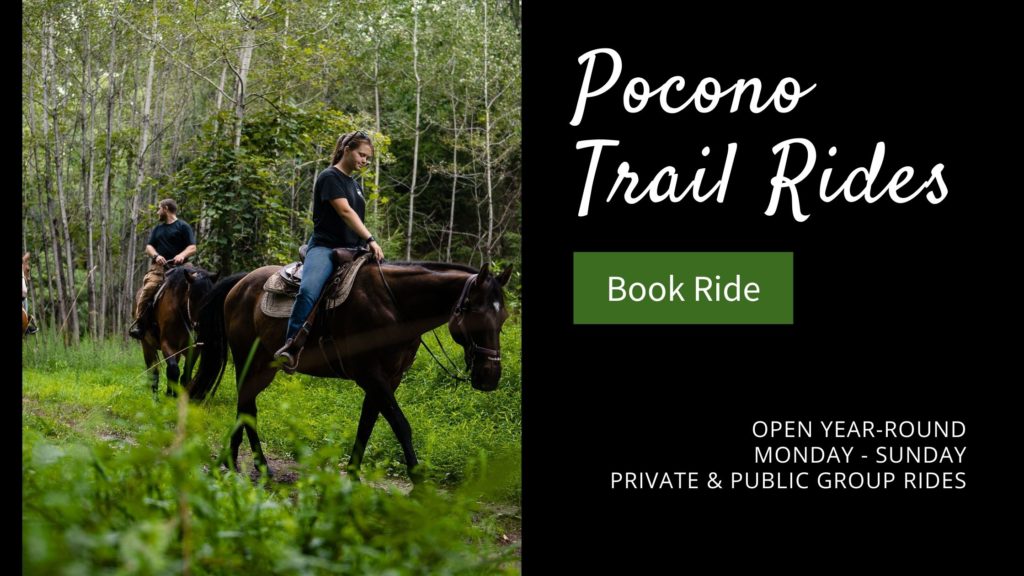
Alan K
Posted at 04:52h, 17 AprilThank you for this useful information. I love learning about a wide array of things and this was a very informative article!
Michele Petty
Posted at 13:51h, 17 SeptemberI’m a city girl and this information was very interesting. Only now that this makes sense I’m wondering about the history of how and when the shoeing of horses began. Hahaha. Hoping to visit a stable some day.
Matthew Jones
Posted at 15:23h, 19 SeptemberGlad that it was helpful! We’ll try to get one together about the history of them, that’s a really good idea! And we’re not sure where you are, but we’re only 2 hours away from NYC and Philly, so hopefully we’ll get to see you out one day!
Reagan S
Posted at 17:20h, 28 SeptemberThis was very informative! I just googled why horses need shoes and this was the top search. Thanks!
Alyssa Strupp
Posted at 17:22h, 04 OctoberVery cool. Just what I was looking for. Thanks.
Roshaun Cooper
Posted at 04:59h, 06 OctoberI’m a philosopher hailing from Fairbanks, Alaska, and I randomly got onto the idea of ethics and horse-shoes.
It was more of a curiosity thing, and I found this article about horseshoes.
It is very informative, I feel like I learned a lot about the actual logistics of the horseshoe.
“Like we said before, horses’ hooves are made of the same material as your nail and, just like when you cut your nails, the horses don’t feel anything when affixing the horseshoe to the hoof. Once the nails are put through the outer edge of the hoof, the ferrier bends them over, so they make a sort of hook.”
During this part of the text, I was relieved to hear that the horses don’t feel anything when the horse nails are put into their hooves. I do wonder, though, if they ever do feel it? I’m a habitual nail-biter, and sometimes when I get a little too far, it kind of hurts. Is there a space on their hoof that ensures painlessness (as far as we can tell)? Is it possible that perhaps an inexperienced, or poor ferrier could somehow mess up the procedure, and scar the horse?
Thanks for entertaining the thought.
Hope you’re safe and well!
Matthew Jones
Posted at 20:09h, 08 OctoberWell, we’re glad you found the article informative!
So, there *is*, of course, a point where removal of the hoof would hurt, but no sensible human would make the mistake of trimming a hoof that far up. In the picture we showed where the frog was: the area directly in front of the frog called the sole (and the frog itself) would absolutely hurt if they were punctured.
That being said, it is not something that is likely to happen, even for a novice farrier. When they trim horses hooves they are only trimming the edge. In addition, horses have to be measured for their shoes, which you do (of course) prior to applying the shoe. Even an absolute beginner farrier would know to use the shoe as a guide: you can place the shoe on the underside of the hoof and trim only what overlays beyond the edge of the shoe.
Now, to address the other implication in your comment, it would be reasonable to assume that horses feel pressure when the hoof edges are cut/trimmed, but certainly no pain. However they *can* bruise the inner structures of the hoof through blunt force trauma. Think of it, again, like your finger: if you tapped really hard on the center of your thumb-nail, the soft flesh underneath still absorbs some of the shock and can become bruised. Horses hooves are much, much thicker than a nail though, so it happens more infrequently than it does to humans.
So, to summarize, though the inner parts of the hoof can indeed be hurt, but even an incompetent farrier would be hard-pressed to make a mistake that would result in that considering that they trim only the edge of the hoof (for further clarification, they don’t touch the top of the hoof whatsoever).